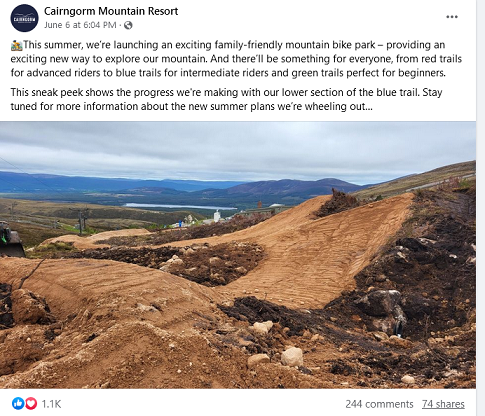 Just over a year ago the Cairngorms National Park Authority approved a planning application (see here for papers) to build “family friendly” mountain bike tracks in Coire Cas at Cairn Gorm. Two magic carpets, to be used as uplift, were constructed just before the start of the winter (see here). The construction of the main trails is now underway and in the last few days several people have contacted parkswatch to express concern about what is going on.
Just over a year ago the Cairngorms National Park Authority approved a planning application (see here for papers) to build “family friendly” mountain bike tracks in Coire Cas at Cairn Gorm. Two magic carpets, to be used as uplift, were constructed just before the start of the winter (see here). The construction of the main trails is now underway and in the last few days several people have contacted parkswatch to express concern about what is going on.
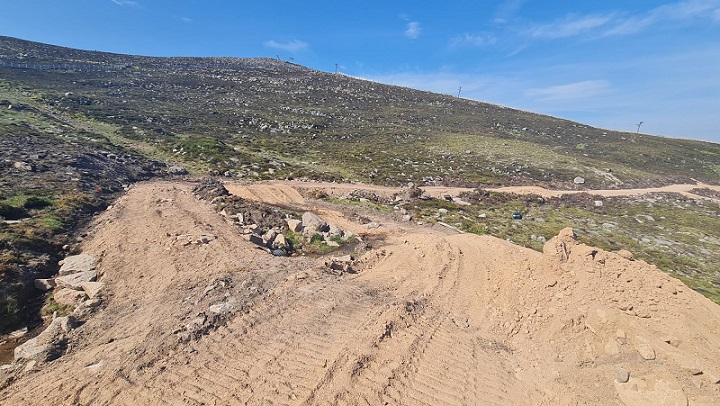
When I wrote about Highland and Island Enterprise’s planning application last year I highlighted a number of deficiencies in the documentation, including the fact that none of the cross sections for the trails showed their width. The CNPA Committee Report subsequently clarified the position, presumably on the basis of verbal assurances from Cairngorm Mountain Ltd/HIE as there was nothing in writing:
“10. The trails are to be constructed of a compacted subbase and finished with a 25mm dust, compacted surface. The widths of the trails will predominantly be of 1 metre or below, with straighter trail sections reduced to 0.75m. Landings and run offs are generally less than 2m for short sections at approximately 6 to 7 metres in length at the feature. A small number of higher rider level features are more than 2m for 6 to 7 metres in length.”
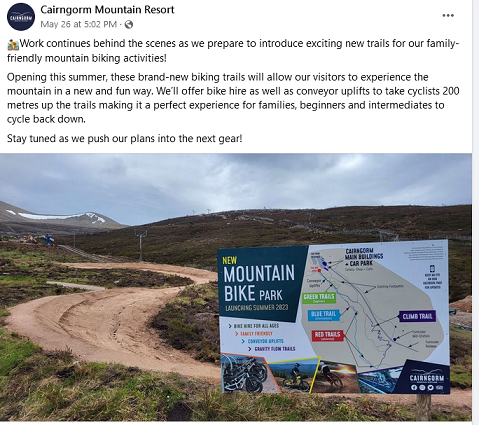 If the trails really are intended to be only 1m wide – and the photos on the CML Facebook photo suggest otherwise – why has the CNPA not taken enforcement action and why has it allowed such a wide construction track? That is completely unnecessary when it comes to creating mountain bike tracks as this photo taken in Glen Coe last week shows:
If the trails really are intended to be only 1m wide – and the photos on the CML Facebook photo suggest otherwise – why has the CNPA not taken enforcement action and why has it allowed such a wide construction track? That is completely unnecessary when it comes to creating mountain bike tracks as this photo taken in Glen Coe last week shows:
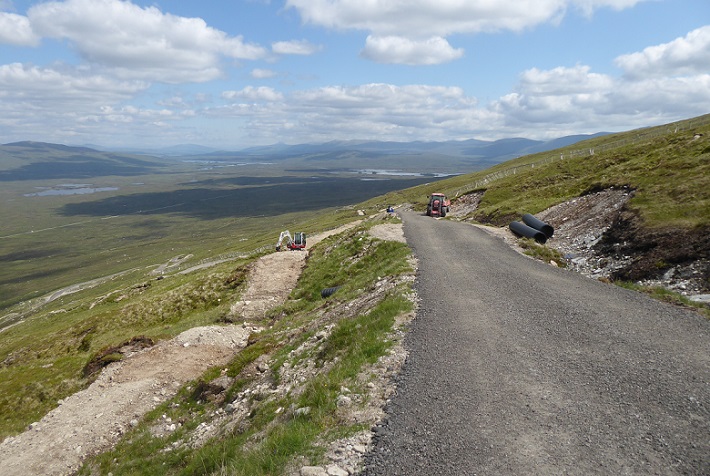
The reason for the enormous construction corridors appears to be that McGowans has chosen to use large diggers and there is nothing in the planning documentation that prevents them from doing so:
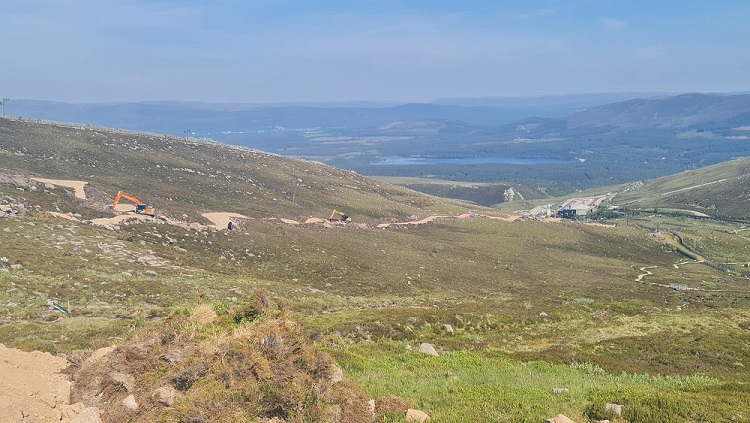
The original Construction Method Statement, which is less than two pages long, starting with some fine words from the designer CRC Trails about the need to take care on a site that is “exceptionally environmentally sensitive”:
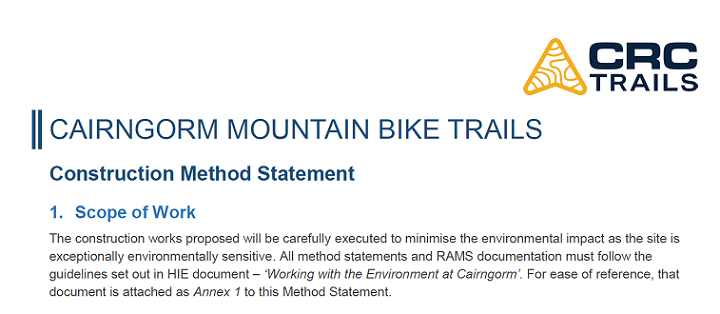 Highland and Island Enterprise (HIE)’s “Working with the Environment at Cairn Gorm” – created from earlier guidance after destruction caused by the Natural Retreats Shieling Rope tow fiasco (see here) – reinforces this, stating:
Highland and Island Enterprise (HIE)’s “Working with the Environment at Cairn Gorm” – created from earlier guidance after destruction caused by the Natural Retreats Shieling Rope tow fiasco (see here) – reinforces this, stating:
“Excavation of turf of grass/heather mat and roots, peat, mineral soil, gravel and boulders should be carefully undertaken”.
In April a further Construction Method Statement was lodged by McGowan, the contractor, and approved by the CNPA. It says nothing about the width of the tracks though it does specify that large diggers would be used. It also contains provisions about the removal and storage of vegetation:
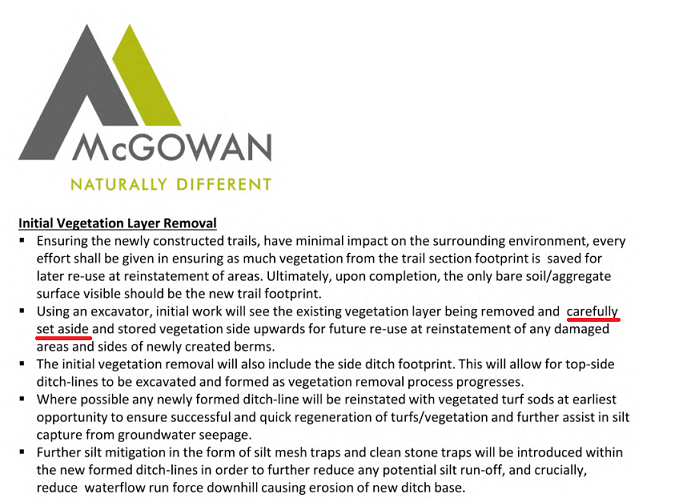 The photo above raises questions about how CAREFULLY the work is being undertaken. One wonders how carefully either the CNPA or Cairngorm Mountain Ltd or HIE are monitoring what is going on?
The photo above raises questions about how CAREFULLY the work is being undertaken. One wonders how carefully either the CNPA or Cairngorm Mountain Ltd or HIE are monitoring what is going on?
What will the landscape impact of the construction?
The works are behind schedule (construction of the higher trails was supposed to be complete by the end of May) and the current drought will affect vegetation recovery this year. That can only increase the landscape impacts of whatever areas are restored in the short to medium term.
It is too early to judge what the longer term landscape impact is likely to be be. The Landscape assessment submitted to support the planning application was not fit for purpose and contained no visualisation of what the tracks might look like:
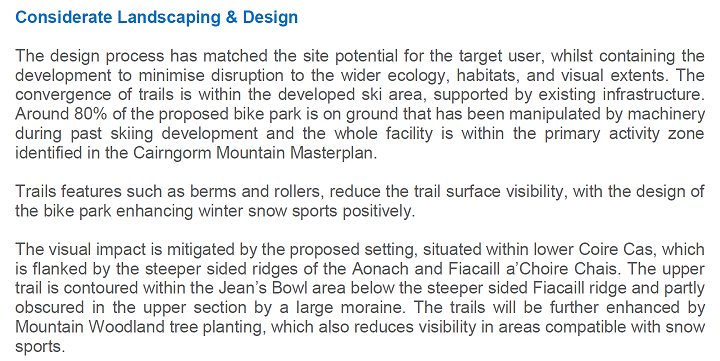 Effectively, the claim in the planning application was that the new tracks would not be visible from afar and since lower Coire Cas was full of snowsport infrastructure what could be seen locally did not matter anyway. It is not clear most visitors to Cairn Gorm would agree, how Coire Cas looks on arrival is crucial to the quality of the “visitor experience”.
Effectively, the claim in the planning application was that the new tracks would not be visible from afar and since lower Coire Cas was full of snowsport infrastructure what could be seen locally did not matter anyway. It is not clear most visitors to Cairn Gorm would agree, how Coire Cas looks on arrival is crucial to the quality of the “visitor experience”.
The photo showing the fresh scar along the sides of Fiacaill a’ Choire Cas suggests that sections of the bike trails may in fact be visible from afar. The report to the CNPA Planning Committee stated that:
“there is some landscape capacity to develop mountain bike trails in-between the Cairngorm Main Building and Funicular Mid-Station…………..it is important, however, that this does not extend
or amplify the existing landscape and visual effects of the ski centre by a significant degree in the National Park”
The planning assessment unfortunately them seems to have ignored this, claiming that:
“the wider context is one of rural development and the addition of this development would be seen in the context of the wider ski infrastructure within the developed bowl of this part of Coire Cas…………, though there will be adverse landscape and visual effects they are likely to be moderate and not significant….. Based on this, the proposal is considered to have a neutral impact on the landscape character.………..”.
From the current evidence it appears that the CNPA’s planning assessment was wide of the mark and the area within Coire Cas that is most affected by intensive development has been significantly extended. As a result the CNPA’s failure to insist on a proper visual impact assessment (showing how the trails would look from various viewpoints) appears particularly negligent.
What needs to happen?
The reason that Coire Cas is being turned into a “rural development zone” is not just because of HIE, who have never been fit to own a large chunk of what should be one of Scotland’s finest mountains, but because the CNPA has in the twenty years of its existence allowed this to happen and made one poor planning decision after another (despite the efforts of a few Board Members).
The CNPA appears incapable of changing course at Cairn Gorm and any solutions there are going to have to come from elsewhere: the Aviemore and Glenmore Community Trust and recreational organisations who value the landscape as being integral to the recreational experience (whether snowsports, mountaineering, walking or biking).
In my view new mountain bike trails could have been created at Cairn Gorm and kept the impacts within acceptable bounds. Such trails, though, should have been and might have been better located in the lower part of Coire na Ciste (where they would be far less visible) than Coire Cas. Indeed, snowsports are unlikely to ever again be financially viable at Cairngorm Mountain unless it follows the example of other ski centres in Scotland and creates uplift that can be used by both skiers and bikers.
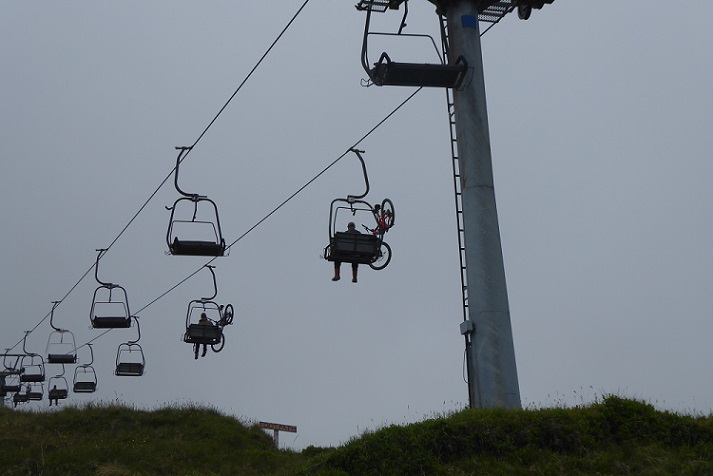
However, the current work shows that the sceptics, like the North East Mountain Trust, who expressed concerns about the development of mountain bike trails at Cairn Gorm may have been right. At the very least no further developments of any sort should be allowed on the mountain until it is transferred to new owners who are prepared to put the landscape and conservation first.

Creating this amount of bare ground in Coire Cas is highly irresponsible. Has HIE forgotten that the public road to Coire Cas has been breached three times in the past due to storm water and silt pouring down the burn below the Cas and then eroding the river banks below? This results in boulders and uprooted trees blocking the road bridge below. The river then takes a different course, slices through the road and endangers property and lives on the rest of its journey to Loch Morlich. Such damage is related to extensive areas of bare ground in Coire Cas, created by badly supervised construction activity.
The Cairngorms have always been subject to intense rainstorms from time to time, especially dangerous when thunderstorms follow periods of dry weather when the rain and silt rapidly run off the dry surface. Given that we now have the combination of such a weather pattern with HIE’s current construction activities in Coire Cas the last place I would go camping in Scotland this summer is the Glenmore camp site.
now you know why I wrote the article about the need to establish a National Wildlife Refugium
Any such refugium should INCLUDE nationally important wildlife, eg our most endangered large mammal predator, the Scottish Wildcat; eg – the Clashindarroch forest and wider surrounding area (outwith CNP), which is being badly mismanaged by managing controllers FES, and although it provided blood stock for the wildcat recovery plan and captive breeding programme, there appear to be NO plans to subsequently release any captive reared wildcat back into their preferred haunts there, just take a look at their appallingly negligent watercourse abandonment, where the cats could and would otherwise hunt. More than fifty watercourses rise in the Clashindarroch, only a handful are in any reasonable condition, and usually fenced off enclosures. Not too kitten friendly.
Bad combination, albeit predictable.
Any such refugium should INCLUDE nationally important wildlife, eg the Scottish Wildcat; eg – the Clashindarroch forest and wider surrounding area (outwith CNP), which is being badly mismanaged by managing controllers FES, and although it provided blood stock for the wildcat recovery plan and captive breeding programme, there appear to be NO plans to subsequently release any captive reared wildcat back into their preferred haunts there, just take a look at their appallingly negligent watercourse abandonment, where the cats could and would otherwise hunt. More than fifty watercourses rise in the Clashindarroch, only a handful are in any reasonable condition, and usually fenced off enclosures. Not too kitten friendly.
Bad combination, albeit predictable.
totally agree. water courses are a very important resourse for wildlife.
Seems to me that the national park are increasingly been seen simply as tourist destinations and so must have all the attractions that tourist expect. The notion that these places are national parks and to my mind to be enjoyed without the trappings of cycle ways, cafes, trains …. But I realise that my thinking is somewhat out of date. As a frequent visitor to Banff national park in Canada I not that recently a major car park has been closed and a limited bus service operates to control access and the environmental problems being caused by the hoards. But it seems in Scotland hoards are wanted and as for commercial interests be tourists or shooting then they are all that matters. Cairngorm as a mountain is basically destroyed to see and enjoy the Cairngorms as a wild place involves more effort than driving to car park and getting on a train. As for the park authorities to call them pathetic is to be overly generous.